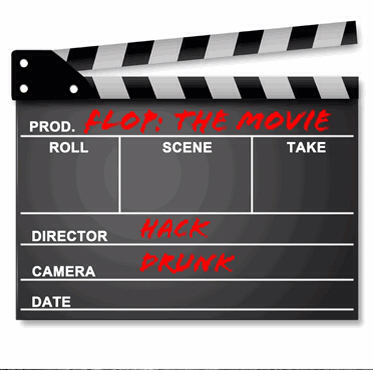Rob Wickings's Blog, page 65
July 26, 2013
Iron Maidens: Bubblegum Crisis Redux
A guest post from a good friend of the site, on a slightly obscure but seriously influential anime. Chris Rogers is back, writing about an anime series that I loved back in the mid-90s, when I first became exposed to Japanimation. Expect more of this kind of post, especially as Pacific Rim has got us thinking about all things mecha and kaiju. Hardsuit go, Chris!  In 1923, Tokyo was devastated by the Great Kanto Earthquake. Nearly half a million homes of wood and paper were destroyed and more than one hundred and forty thousand people died in the tremor and firestorm that followed. The city was slowly rebuilt along modern lines, with higher construction standards and new technology, and after the second world war became one of the globe’s greatest metropolises.
In 1923, Tokyo was devastated by the Great Kanto Earthquake. Nearly half a million homes of wood and paper were destroyed and more than one hundred and forty thousand people died in the tremor and firestorm that followed. The city was slowly rebuilt along modern lines, with higher construction standards and new technology, and after the second world war became one of the globe’s greatest metropolises.
But over a century later, in 2025, Japan’s capital suffered the unthinkable: the Second Great Kanto Earthquake. The city was once again reshaped by ground heave and landslide, its port inundated and its buildings – though now of concrete and steel –toppled. Recovery seemed impossible. However, the power of the zaibatsu (mega-corporations) had grown exponentially by the first quarter of the twenty first century and salvation duly arrived in the form of the giant Genom Corporation. Dominant in infrastructure, bio-technology and defence, Genom’s resources were applied on a massive scale. Use of robotics enabled reconstruction at an unprecedented rate. A new underground railway was completed, along with kilometres of urban freeways. Power came from solar, wave and thermal sources. In seven years a gleaming new capital emerged from the ruins – Mega-Tokyo.
Yet this rebuilt city was not perfection.
An immense fault nearly fifty metres high, the geological legacy of the quake, cut across the city, dividing it and its population. Crime festered in the literal underworld of sewers and drains, riverbeds and basements. The vacant lots and remaining rubble piles became battle grounds for biker gangs. Marine City, built on reclaimed land in Tokyo Bay, lay unfinished and abandoned. A disturbing new threat appeared – mechanical humanoids called Boomers, immensely strong, heavily armed and highly agile, against which the beleaguered Armored Defense Police (ADP) struggled. And there are darker whispers, of Boomers with simulated human flesh covering their chrome-plated skin, of corrupt links between the civil and military powers, of the assassination of key figures including scientists and politicians.
For most citizens, though, life in the renewed city was good. They went to work, to school and to the shopping malls, chatted, played and relaxed. Among the crowds were four young women, each very different: Linna, an aerobics instructor at a dance studio; Nene, a data operator for the ADP; Priss, a successful rock singer; and Sylia, businesswoman and lingerie shop owner. Alone, each was an orphan, a runaway, abandoned. Together, they are a vigilante mercenary group protecting Mega-Tokyo, fighting Genom’s Boomers with the hardsuit technology invented by Sylia’s murdered father.
Together, they are the Knight Sabers.
This dramatic scenario was conceived in the late 1980s by Toshimutsu Suzuki for Bubblegum Crisis: The story of Knight Sabers Mega-Tokyo 2032-2033, a new multi-part science fiction action drama serial to be released as an Original Animation Video. Particular to Japan, the OAV allowed writers, designers and directors to explore new ideas without the high cost or risk inherent in cinema or television. It was hugely popular in a decade that saw video cassette recorder ownership explode.
Suzuki’s deceptively light main title was actually a metaphor for the moment of maximum tension in any situation, the tipping point at which the Knight Sabers operate. The secondary title alluded to the unusually complex narrative structure of the venture – events would take place over a full year in the lives of both the characters and the city. Within this there was further intricacy; of the eight instalments made (thirteen were planned), the first three form a self-contained trilogy whilst numbers five and six are a two-part arc in their own right. The remaining episodes stand alone but many threads connect them.
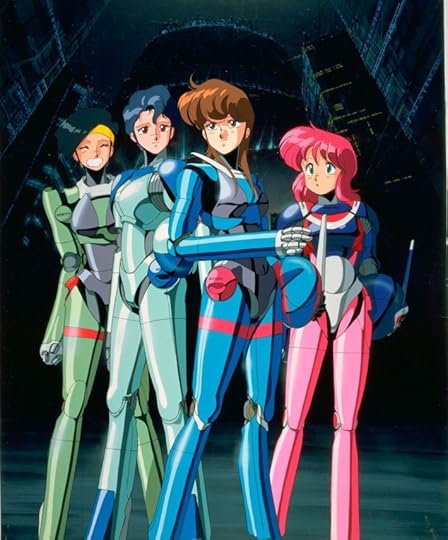
L-R: Linna, Sylia, Priss, Nene. Ladies and gents, the Knight Sabers!
The new work would break ground in every way. Thematically Suzuki would draw on both Eastern and Western tropes and exploit the burgeoning cyberpunk movement to craft a complex, engaging, long-form drama that aspired to transcend the anime format. Director Musani Akiyama would innovate by borrowing from Hollywood and that other trend of international contemporary culture, the pop video: fast cutting, parallel editing and dynamic camera angles and compositions would power the visuals. Having a small number of core characters that work together allows Bubblegum Crisis to neatly bridge Japanese and American storytelling conventions.
The four leads are differentiated by personality as well as haircut and colour and hardsuit design, and the headstrong, rebellious Priss, dweller on the city fault line and initiator of most adventures, provides the touchstone for the kind of single protagonist approach to drama that is generally viewed as Western in style. But this same focus on the individual is in fact found in the East too, ensuring the series is not too distanced from its roots, and the portrayal of strong females is in any event a very common if little-recognised feature of manga and anime. 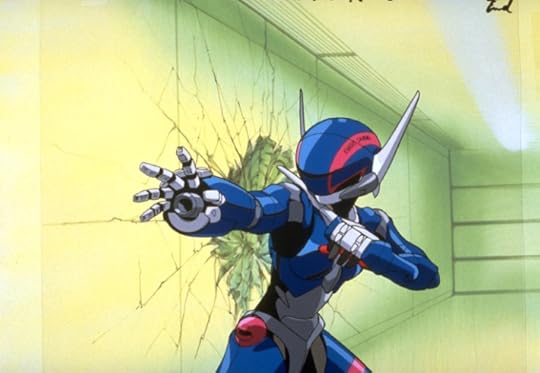 Group identity, conversely, is extremely powerful in Japanese culture, and throughout Bubblegum Crisis the Knight Sabers come together at the climax of each episode. The Knight Sabers’ Transformer-like motoslaves – motor bikes which unfold to become exo-skeletons, boosting the hardsuits’ power – carry this idea through with commendable thoroughness. The pairing of ADP detective Leon and his partner Daley mirrors this, as to a lesser extent do the machinations of Genom’s executives and even the Boomers.
Group identity, conversely, is extremely powerful in Japanese culture, and throughout Bubblegum Crisis the Knight Sabers come together at the climax of each episode. The Knight Sabers’ Transformer-like motoslaves – motor bikes which unfold to become exo-skeletons, boosting the hardsuits’ power – carry this idea through with commendable thoroughness. The pairing of ADP detective Leon and his partner Daley mirrors this, as to a lesser extent do the machinations of Genom’s executives and even the Boomers.
Of course the crime-fighting group is a popular conceit in Western procedural drama. Disguised crusaders against crime, whether lone or in teams, have a long tradition in popular Western mythology, but the Knight Sabers’ all-enclosing hardsuit also speaks to a rich use of masks and other forms of facial concealment in Japanese culture, from noh and kabuki theatre to samurai armour. One could even read the hardsuits as a late twentieth century interpretation of bunraku, in which puppets follow the movements of their (largely) unseen operators.
Certainly the hardsuits are Bubblegum Crisis’s most obvious manifestation of the obsession with joining man and machine that is such a prominent aspect of Japanese science fiction. There are many more examples in the series, often fusing human beings to weapons systems or other mechanisms; in the case of Revenge Road, a car which channels its driver’s desires acquires sentience and acts of its own volition. The aforementioned Akira, Tetsuo, Ghost in the Shell and Silent Moebius explore the same idea, as do the Patlabor and Gundam universes.
Dating from the 1950s, this fixation can be read as a response to concerns over the country’s rapid post-war re-industrialisation and expansion and the loss of control that this might bring. That said, the depiction of technology to a level of detail that borders on the fetishistic is also common in Japanese science fiction, and Bubblegum Crisis fully embraces this. Satellite weapons, one-man micro-helicopters, fan-powered aircraft, Priss’s outrageous Highway Star motorcycle and a spider-like walking tank all feature, and anticipate many live-action Western productions of the following decades.
Of course Bubblegum Crisis shares the fault of almost all science fiction in failing to actually predict the future – the internet and mobile phones are entirely absent, with characters instead using electronic letters (floppy disks sent through the post) and public call boxes. Boomers vary from this author’s favourite, the crustacean-like BU-12B combat model, through the many generic henchmen, to the growling, animalistic, exo-atmospheric Doberman.  It is series designer Kenichi Sonoda’s hardsuits that have brought the most intense adulation from fans. The sleek lines of this elegant, close-fitting powered armour recall fashion mannequins, motorbike helmets and the robot Maria from Lang’s Metropolis. Their smooth, seamless surface finish pays homage to the enamelling and lacquering techniques practised in ancient Japan. Naturally, their feminine lines (note the high heels) clearly appeal to the overwhelmingly male fanbase of science fiction anime on a rather different level.
It is series designer Kenichi Sonoda’s hardsuits that have brought the most intense adulation from fans. The sleek lines of this elegant, close-fitting powered armour recall fashion mannequins, motorbike helmets and the robot Maria from Lang’s Metropolis. Their smooth, seamless surface finish pays homage to the enamelling and lacquering techniques practised in ancient Japan. Naturally, their feminine lines (note the high heels) clearly appeal to the overwhelmingly male fanbase of science fiction anime on a rather different level.
Directorially, Akiyama uses fluid pans around characters, rapid pull focus and unusual scene transitions – a blank screen is suddenly revealed to be the rear face of a firing range target, for example, when shots punch holes through it. Split screen is used to show the Knight Sabers’ faces behind their visors. In a pre-CGI age, cel animation is pushed to its limits as coloured neon sculpts the cityscape of Mega-Tokyo against the ink-black night, and water is rendered very believably, whether in swimming pools, running along drains or pouring from taps. Akiyama’s handling of the medium is assured, while simultaneously stretching its possibilities. The highly cinematic cold-open pre-credit sequences of the initial trilogy are especially effective.

Priss, sans hardsuit.
From vehicle designs to sound effects to the shape of the GPCC pyramid to the shots of tiny lit flyers flitting through the night, the influence on Akiyama of contemporary American films, most notably Aliens and Blade Runner, is immediately apparent. Walter Hill’s non-genre Streets of Fire is also heavily mined; its opening sequence is paralleled at the start of episode one, which also showcases the final element in the success of Bubblegum Crisis – its soundtrack.
In addition to the instrumental music by Kouji Makaino, more than a dozen original songs performed by the cast are featured, either as background to specific scenes or as part of the on-screen action. They move in style from lyrical and reflective to visceral and thrilling, this last including the series’ signature tune Konya wa Hurricane, and several musical cues overall are virtual copies of the Streets of Fire score. This use of songs was almost certainly inspired by the contemporary American television series Miami Vice.
Bubblegum Crisis burst onto the Japanese market in early 1987, winning an immediate fan base. Amongst an abundance of merchandise, soundtrack albums were some of the biggest-selling items and members of the cast even toured Japan with live gigs. Episodes were released one at a time over the next three years, and the animation and camerawork improves noticeably in quality and ambition as the series progresses. Crucially, along with the film version of Katsuhiro Otomo’s Akira, Bubblegum Crisis became one of the first anime to be seen in Europe and America, initially through bootleg fan copies and then, in the early 1990s, distribution of official editions.
With a nice touch of irony, corporate changes led to the curtailment of the series. Storylines intended for the remaining five episodes were eventually merged to form the three-part continuation Bubblegum Crash. With a different cast and crew and cruder production values, it is not regarded as canon. A spin-off series concentrating on the AD Police was also made. More recently, Bubblegum Crisis Tokyo 2040 appeared on television as a remake of the original. More than twenty five years later, Bubblegum Crisis remains a milestone of visual entertainment. Compelling, exciting and sometimes beautiful, its energy is infectious and it stands up surprisingly well today. It’s time for more to hear the cry “Knight Sabers, sanjo!”
Chris Rogers writes on architecture, film and other aspects of visual culture for various outlets including Little White Lies, The Big Picture and Art of England; his work can also be found on his own website, http://www.chrismrogers.net  Coming up: we look at the American graphic novel version of the BGC universe–a controversial book that took a lot of heat when first published.
Coming up: we look at the American graphic novel version of the BGC universe–a controversial book that took a lot of heat when first published.


July 24, 2013
Page One Rewrite: The Trouble With Film Reviews
There's a big problem with film criticism in the 21st century. There's simply too much of it.
“That's rich!” you holler. “This, coming from a bloke who spends a fat chunk of his blogging life talking about film.” This is all true, although the observant amongst you may have noticed filmcrit taking a quiet back seat on the site recently. There's good reason for that.
The problem is that if you throw a wide enough net for any given film, then you can gather in a specimen of every species of film review, from high-five to hatchet job. Let's take an example: Noah Baumbach's quirky character study starring and co-written by Greta Gerwig, Frances Ha, that dropped on Friday. Cath Clarke, writing for Time Out, called it a:
“charming, drifty indie comedy, shot in gorgeous black and white… it feels totally honest.”
Of Gerwig, she says:
“a kooky, clumsy cool girl in the tradition of Annie Hall.”
Meanwhile, over at Box Office Buz, Andrew Jones has a slightly more jaundiced view:
“Frances Ha is so annoying… that you want to grab the film by its throat, screaming about how bad it really is.”
Of the choice to shoot in black and white, he said:
“an absolute eyesore of a film, the black and white effect just makes everything uglier and more dull to look at.”
There you go. One film, two polar opposites of reviews. Good luck making a decision based on those two. The thing is, they're probably both right. Cath and Andrew are passionate, well-informed writers. They're both fans of Baumbach's previous work. But it's clear that their stances on Frances Ha are both wildly divergent and, perhaps, based on all sorts of factors: their own predilections, how they were feeling when they wrote the review, how much kip they got the night before. This is not a slur on their professionalism or the validity of their piece. There's no point in having a purely objective film review – you'd get something like “the film was generally in focus and well-lit, the actors hit their marks without issue and no-one flubbed a line.” Both are equally valid – but neither is particularly helpful if you want to know whether it's worth splashing out for a ticket and a babysitter.
The point and the problem is that any review is, by definition, an opinion. Yeah, really, no duh, big revelation, right? But the thing is, we're longer in the world where the only opinions we had to filter were those of the newspapers, a couple of film mags and Barry Norman. For ill or good, there's a lot of people out there with a movie habit, the urge to write about it and the means to find an audience. Five different reviewers will have five different opinions of a film. Now factor that by, oh, let's say ten to the power of twenty. That's yay to nay and every shade in between. How can you base a trip to the flicks on that sort of baseline? Is it any wonder that commentators are calling this the end of the era of the film reviewer?
Anyone trying to make a name in the game these days needs a hearty sense of self-awareness and an acceptance of their role and potential influence in the scheme of things. Rotten reviews won't chop a film off at the knee any more – just look at the box office takes for the universally derided Transformers films. Good reviews will help, but more often than not now they're all just a part of the promotional machine for a new release. There's an element of back-scratch at play here, of course – it's a rare film writer that doesn't want to see a pull-quote on a poster or ad, and it's pretty cool to snag free press screenings. Does this mean that access comes with a certain amount of leeway in terms of positive reviews? No, of course not. Well, not on a reputable site, anyway. But there are other weapons that the marketing team can bring into play in their hunt for a positive write-up.
Crowd-sourced reviews, for example. It's becoming more common for preview screenings to come complete with a camera set up to grab on-the-spot vox pops from the people that matter – the little people in the audience. You'll often find them composited into TV spots, especially if the film in question has been critically pummelled.
This can backfire, though. The studio behind Richard Curtis' new film, About Time, thought it would be a great wheeze to have members of the public write reviews following a tranche of preview screenings. That is, until the reviews came in. They were unanimously stinking. The studio panicked, and started throwing out cease-and-desist orders. But as no-one in the audience had signed an NDA, Working Title were not so politely told to shove it. Something of a failed experiment, that one.
Then of course there is the aggregated film score, brought to you by Metacritic or Rotten Tomatoes. Like an Amazon review, these bring you a broader overview of reviews, sorted into a handy star or freshness rating. This is fine in principle, but again ignores the fact that bad notices don't necessarily equate to poor box office receipts. Especially when studios can make up pull-quotes out of just about any bit of copy, regardless of how excoriating the review.
Let's go back to Frances Ha, and Andrew Jones. A mischievous PR person could quite easily turn that frown of his upside down, with a little judicious editing. Let's see, now…
Ahem. Andrew Jones, writing for Box Office Buz, calls Frances Ha:
“charming… off-beat, quirky innocent fun… a sweet, innocent look at a young woman and the friends she makes on her journey to stay childlike for just that little bit longer before life comes a knocking.”
There. Much better. Go back and read the whole review (Please. Give the guy some traffic. It's the least I can do under the circumstances). It's all there. Out of context and heavy on the ellipsis, but in the copy and ready to be retasked. Note that a lot of quotes on posters don't even put the 60 seconds of work in that I did. A single word will do, even if that word is comparing the film reviewed with another, better movie. It's a low, dirty trick, but it happens, and more often than you'd think. And if it gets your name and web address on a poster, are you really going to demand the studio pull it down?
The film review world is increasingly skewed and hard to live in, and the rewards, to my mind, are becoming tougher to find. There's art and wisdom to be found in the best film blogs and sites, but you have to wade through a shedfull of dreck, pablum and churnalism to get to it. It's been a long while since I read a film magazine from cover to cover, and I pick my movie sites with increasing care. Ultimately, if your own reviews can be turned around to say something other than the thing you intended, how on earth can you craft something meaningful?
I'm not convinced I have anything new to offer anymore. I will continue to offer film writing on Excuses And Half Truths, and we'll continue to talk about film on The Speakeasy. But writing about current releases… that needs a new approach. If a flash film review of a couple of hundred words can have the same impact as a 2000 word behemoth, then maybe less is more. I'd love to know your thoughts, Readership.
See you in the cheap seats.


July 17, 2013
My NHS
I look at the horror stories in the press about the NHS, and then I compare them to my own experience within the service. The two do not mesh.

I have a chronic immune-system disorder known as psoriasis. For many years, it was considered to be a skin disease, as the main symptom presents as large, unsightly “plaques” of rough, angry-looking scales on the trunk, arms and legs. Research over the last ten years has given us a much greater understanding of psoriasis, and how to control, if not cure it.
I’ve been attending Guy’s and St. Thomas’ Hospital, home to one of the best dermatology departments in the country, for management of my psoriasis. I was referred, free of charge and without fuss, by my GP. They’ve been brilliant, guiding me through different types of therapy and treatment.
Recently, I realised that my current course of medication wasn’t controlling the plaques as well as I liked. I elected to up my game and try a systemic treatment – basically, popping a pill.
Systemic treatments work for psoriasis by slowing down the immune system. I know, this sounds like a terrible idea. But bear in mind that the disease is effectively caused by my immune system revving out of control. Calming things down on the inside makes for a much less angry result on the outside.
However, it’s a delicate balancing act. In order to get the go-ahead, I needed to get green lights on liver function and cholesterol – both of which are affected by psoriasis and the systemic treatment for it. My results came back and sadly, they weren’t perfect.
So, for the last three months, I’ve been undergoing a fairly intensive round of investigation. I’ve been through consultations with leading lipid and liver specialists, undergone ultrasound and fibroscans, and lost very nearly an armful of blood to tests. I was called into my GP to go over the results as they were coming in, giving me perspective and more importantly, easing my worries at some of the scarier numbers. The whole process
has been carried out with professionalism, good humour, patience and empathy by everyone I’ve met, from receptionists to nurses to the highest consultants, even when it was clear that they were overworked and understaffed.
The end result: I’m pleased to say that I’m now on a systemic treatment called acetretin, which should start to clam things down in a few weeks. The end cost to me as a user has been the meds. £7.85 for a four month supply of acetretin, and the same for a two-month supply of a statin to work on my cholesterol. Grand total: £15.70.* Try and get that in the US-based model that the Tories are trying to impose.
To conclude, when I watch Jeremy Hunt on Newsnight claim that the NHS is an archaic, broken system, I look at the evidence I have at hand and can only conclude that the man is ill-informed, an idiot or has another agenda. For me, the NHS has always delivered on time and on budget. It’s never let me down. This is more than I can say for Hunt and his cronies. If they’re after an outdated, unaccountable structure to blame for slipping standards, perhaps they should be looking a little closer to home.
*yes, I’m aware that’s not a one-time cost.


July 15, 2013
Money and Modern Love: X&HT Talks To Simon Aitken
Crowd-funding can, and has been proven to work brilliantly for most creative endeavours.
But for films it's always been a little more problematic. Having money to make a film is still no guarantee that a film is going to be made. And it's certainly no guarantee that said film is always going to be any good.
Simon Aitken, the man behind Blood + Roses and a friend and fellow-traveller on the no-to-no budget path, has always been a little cynical of the crowd-funding model. That has changed, as he's launched a campaign on Indiegogo to raise money for his latest endeavour, Modern Love. I caught up with Simon to find out what's changed his mind.
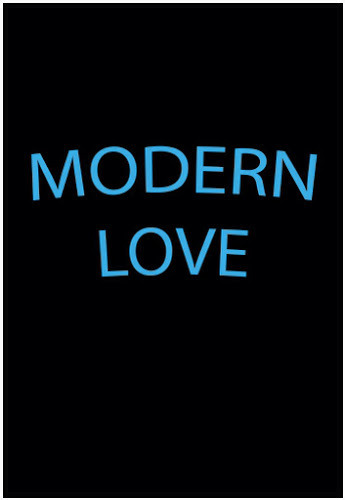
Rob: Thanks for taking the time to talk to us, Simon. So, the big question up front: what changed your mind about crowd-funding?
Simon: I've been trying to get my next feature made since I finished Blood + Roses, with little success. Blood + Roses didn't open the doors I hoped it would and the feature scripts I have written are currently just sitting on the shelf, gathering dust. I have seen my peers go on and make their films through crowd funding. I felt like I was being left behind. I thought that it was something that I at least needed to try.
Out of all my feature projects, this one would need the least amount of money to make. I've already shot 2 of the stories, Without Subtitles and Digital Romance, so I was already in production with this film, and I had something to show of what the overall film would be like.
I've also had a lot of support from Dianna Ippolito, the scriptwriter of To The Passerby short in Modern Love. She suggested that we raise the money for the short through crowd funding, but I decided to do it for the whole film. Thanks to Dianna I realised that people out there would put money into my film.

Rob: Tell us a bit about Modern Love.
Simon: Modern Love is an anthology film made up of 15 short stories about love, dating and romance in the modern world. The stories have different characters, in different situations, some good, some bad. I've chosen to set them all in London. The stories will be funny, sad, uplifting, ugly… but they'll all be realistic. No Hollywood schmaltz in this film.
Rob: Amen to that. You've always been a model of fast, lean film-making to me. What's the Aitken Way of putting a film together?
Simon: I make movies any way I can. It always depends on budget. If I had a big budget I would shoot on the Arri Alexa, but saying that, I do enjoy shooting with DSLRs. I'm currently using a Panasonic GH2, which I will be using on this film, but I will shooting again with the iPhone.
I currently do all my editing on Premiere Pro CS6. I find it funny that I'm using Premiere again. I used to edit on Final Cut Pro, but since FCP X I have gone back to Premiere and I haven't looked back. Though I still colour grade on Apple Color. I haven't changed there.
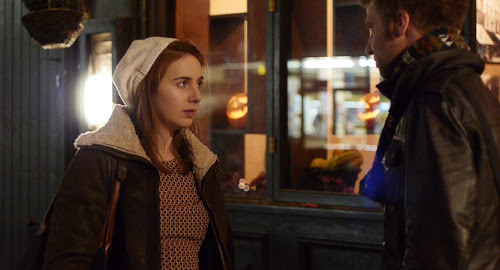
Simon's Indiegogo project for Modern Love is now live at the link below. Some of you may have been lucky enough to see Without Subtitles or Digital Romance at various short film screenings. If you have, then you know the quirkily humorous appeal that Simon brings to his stories of love in the digital age. I reckon this one is worth your attention, and your investment.
Go on, give Simon a little bit of your love.


July 9, 2013
The Unconventional Accountant: X&HT chats with Mike Tack
I was at BrianeHownd last week, largely to check out the new short by a film-maker who I think has a real future.
Mike Tack doesn't, at first glance, strike you as a horror director. When we first met at a Feast On Film night last year, this gentle, impeccably-suited gent in his late forties seemed a little out of place.
The film he showed, “The Domestic”, shot on an iPhone with a budget of about a fiver, was a hilarious and vicious horror short with a real sting in its tale. I was instantly intrigued, and we struck up a conversation.
His latest film, “One Careful Owner”, is a major step up. Shot on DSLR, and taking the very wise step of featuring everyone's favourite Leading Man, Clive Ashenden, Mike dialled down the humour and upped the brutality to show a stunned BraineHownd audience an uncompromising morality tale.
I caught up with Mike after the screening to chat about his life in film.

Mike (with camera) assures Leading Man Clive that there's nothing to worry about.
Rob: Let's start with a potted history, Mike. Who are you, where are you from, what have you been up to prior to starting your filmmaking career?
Mike: Ok, I live in St Albans and have done since I was 10. I'm currently working at a job that doesn't exactly fulfil all my creative ambitions… yes, I'm an accountant! Having said that I have always been described as an unconventional accountant. I am married to my wife Louise and have 2 stepsons, Kyle and Ryan. We also have 1 dog, 3 cats (I am a total cat lover and would chop up anyone who had the balls to harm them) 4 chickens plus a horse on a farmer's field. We also had 2 dynamite crabs but they now reside in Davey Jones' locker ha hah hah.
Rob: You're a slightly unusual figure as you're quite a bit older than the usual horror film crowd, especially at the short film level. What brought you into the game now?
Mike: Ah, quite a bit older as in 50 this year – thanks for that – but hey at least I have lasted that long! To understand why I now am “in the game” you need to go way back to 1972.
I have been into horror since I was 9 or 10. House of Hammer magazine was the mag which captivated me (the entire collection is in the loft) with all its comic strip Hammer film adaptations, reviews and black and white images of Suspiria, Squirm and Texas Chainsaw.
I suppose my psyche had been shaped from an early age by Hammer Films. I collected Monster Mags, bubblegum cards with Christopher Lee's bloodshot eyes searing from the card. My mother was particularly upset when I blu-tacked a massive pic of Christopher Lee's monster from The Curse of Frankenstein onto my bedroom door. I also collected horror books by Alan Frank, Kim Newman and loved discovering films I had never heard of. Throw into the mix BBC2 Late Night Horror Double Bills and the advent of the VHS player you can see I was doomed to be a horror addict.
I even collected colour sound 8mm movies and fondly remembering buying a 50ft reel trailer for Phantasm. Once, I hired a full length print of THE TEXAS CHAINSAW MASSACRE and screened it to the local kids on my projector in my living room charging a small fee to cover the hire costs. This was when the film could only be seen in London with a GLC certificate X. I wonder how many of them had a good nights sleep after that… I also have an evil sense of humour – I don't know which came first, my humour or the horror.
Ok, so back to August 2012. I had watched a short film at Frightfest which I thought was total shite. I came outside for a fag, ranted about how crap the film was, then said I know – I'll make my own short film (I sort of had an idea rolling around for a few years which became THE DOMESTIC), I'll do it on my iPhone because I don't know how to use any other type of camera and I'm skint.
So 2 weeks later with Kyle, my stepson, in tow with his Mac Mini and a microphone and me armed with a couple of gadgets for iphone, a 400w builders light and some blue rope, fake tongue, lidl skill knife, fake blood, cotton buds and the infamous PLASTIC SHEETS I was on location in Brookland, near Ashford in Kent at my mates house, torturing the shit out of him.
I mean, making a horror film.

Film-making is fun.
Rob: Your films are great because they take quite mundane, everyday frustrations and twist them into something really rather impressively nasty. Is this a path you're going to explore further? If so, any hints as to what we can expect?
Mike: I have seen a lot of other short horrors, and even though they have shitloads of great gore fx, pro makeup and buckets of claret going everywhere, the stories themselves are still a bit soft. I feel that they lack balls and I think that it's the mundane situations we all experience everyday that I want to explore.
I also want the audience to feel something. After all a horror film needs to be horrific not “hey look at that brilliant CGI blood creature effect that has no place in reality…”. I purposefully think up “button presser” moments of violence which if handled with a good setup will freak the audience out. In ONE CAREFUL OWNER I knew before I shot a single frame of film how the pacing was going to work. I wanted the audience to feel like they are there as an unwilling witness and that the only way they can escape (unlike the victim) is to go running out of the cinema.
I suppose I get a lot of satisfaction from manipulating the emotions of the audience and am over the moon if I can actually impact on their feelings just through them watching my film. I am a musician and the same applies – if your music affects someone to the degree that one note can send a shiver down someone's spine… to me that's amazing.
My next project TURN OF THE TIDE will be a bit different as it's mainly a chase film similar in tone with North By Northwest. But again it's taking an everyday situation and turning it on its head. After that I have another screenplay I have written called THE VIEWING which will be my take on a more supernatural jump scare type of film. So I am moving away from the torture porn type of film or “oh shit look at all those plastic sheets on the wall” feel. After that I will be looking to do a feature which I have already started writing called EXECUTIONERS which will be a film noir futuristic mash up of everything I've done to date.
Rob: Tell us a little bit about your filmmaking influences and heroes. If you could meet and get tips from one filmmaker, who would it be and why?
Mike: I think that Alfred Hitchcock is probably the filmmaker who I would like to get tips from as I adore his films and his craft. He is the one I have studied most closely whilst watching his films. I also like early John Carpenter stuff, and of course George A Romero. I also love Terence Fisher's work on the Hammer Films, Stanley Kubrick, Francis Ford Coppola and two of my faves Brian DePalma & Dario Argento (early stuff as his output since Sleepless is absolute shite). I don't know if my own style even exists yet so I don't know if they have influenced me.
Rob: Tell us a bit about the Mike Tack method of making movies. What one thing would make your life as a filmmaker easier (we can take “more money” as a given, I think)?
Mike: Early on I realised that you need a great story. No point going to all that effort if the story is shit. So first I get an idea, brainstorm a screenplay out on my computer – re-draft 3 times or so, tightening the script and mentally taking note of how I see it in my head, as if it's already made. Then I work out locations, props needed, wardrobe and also what gore fx gags will be needed and how the hell are we going to do them on no budget.
I have built up a small group of reliable enthusiastic actors and crew who I then alert and confirm their involvement. Once the shoot has been done and my bank account is lighter by a few hundred quid to cover food, travel, wardrobe and so on, I edit and grade the film on my Mac and Kyle gets the soundtrack sorted. Kyle, Louise and I always add our own thoughts at each stage to each other's work so it's a really collabarative process and good family fun too!
The thing to make my life as a filmmaker easier would be to have no submission fees and online links to screeners when submitting to festivals. I have blown over £240 on submission fees to give my film to someone else to show at their festival they are charging other people money to attend! We all want our work shown at a cinema with a big audience. It's just a shame I have had to spend the entire budget of the film again on asking if someone can screen it – and the real kick in the bollocks is that they may not even show it! How twisted an arrangement is that? Rant over….for now!
Rob: I thought One Careful Owner was a great, sharp piece of horror, and I was honoured to be one of the first to view it. What are your plans for it over this festival season?
Mike: Well, Rob, I'm glad you liked it! I have just spent my last £27 submission fee so I will only be putting ONE CAREFUL OWNER into festivals that have free submission. We've had a great 8/10 review from review site UK HORROR SCENE (read it here) and American site INDIE HORROR FILMS (read that one here). After the great reception at the test screening you attended I have high hopes that it ticks all the boxes – at least on the horror festival circuit.
I also think the film “works” and tells a big story in only 11 mins. I also love that it may be a bit strong for some people so I am hoping for a bit of notoriety – it's all good press!
The film has already been officially selected for Horror-On-Sea for Jan 2014 and I have a planned festival run up to July 2014. As a family we love going to watch my film play to an unsuspecting audience and meeting other filmmakers – it's a great excuse to go out as we don't generally do that enough. So the filmmaking is a big positive in my family life too as well as the obsession it has now turned into.
Rob: Finally, what are your plans for the future? What can we expect from Apocalyptic Conservatory Studios in the second half of this year and into 2014?
Mike: I hope to get my own DSLR camera for £500 ish and some basic slider and hand held DIY stuff made – I'm on a no budget here!
The rest of this year will be taken up with TURN OF THE TIDE which will be filmed at a number of different locations. Some of those are 100 miles from where I live so that's a first. I even did a location scout taking pics of possible places to film – see how everything is changing all the time – the scope of each successive project seems to grow and grow as I get bigger ideas. Having said that lack of money is not going to stop me. I will find a way even if it means getting arrested! I also will be using green screen fx for specific gore fx I have in my head so I will be doing a lot of self tuition in Adobe After Effects – YouTube has a lot of great tutorials.
I will also continue writing my feature length screenplay EXECUTIONERS when I can, although that project is firmly in the “watch this space” category.
I will be waiting to hear which festivals want ONE CAREFUL OWNER. Frightfest have got the first dibs on the World Premiere so fingers crossed on that one.
I am also waiting to hear about two Frightfest “turn your bloody phone off” idents entries I filmed in May/June and if our SIX FEET UNDER 3min entry to the SHORT CUTS FROM HELL competition is to be one of the final 6 selected.
As for 2014, hopefully I can start submitting TURN OF THE TIDE for the festival circuit and film THE VIEWING for 2015 submission. Then it will be feature film planning/financing etc all the way – unless of course there are some other short film competitions which if I have the time I will go for.
There you have it. A writer/director that's gnawing at the bit to get his films made and seen, regardless of budget, with a focus on the right story and doing his darnedest to freak out an audience. Mike Tack, you're our kind of film-maker. Excuses And Half Truths salutes you!
Watch out for One Careful Owner at festivals this summer, or take your own trip into Mike Tack's dark imagination at his website.
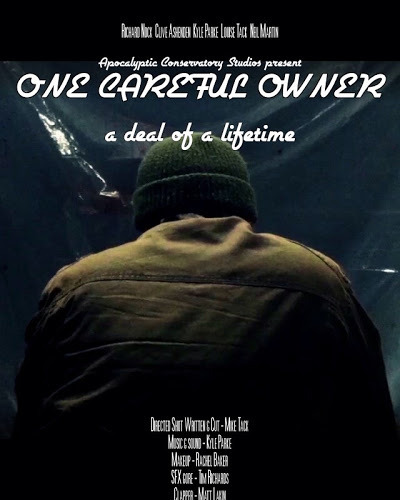


July 1, 2013
The KLF for Glasto 2014? Bad idea…
There’s been low-level chatter around Twitter this weekend regarding the lacklustre, corporate smug-fest that Glastonbury has mutated into.
In many ways, it’s fair comment. The headliners are dull pablum, the glampers are out in force. The whole thing needs shaking up. Glastonbury needs a new call to arms.
That call has gone out to Drummond and Cauty. Bring on The KLF to headline Glasto 2014. Give the festival the same treatment that they gave the Brits and the Turner Prize.
It’d be great! They’d play all the hits, maybe get Jessie J to do the Tammy Wynette bit. Encore with Doctorin’ The Tardis. Bring on a proper Dalek. Maybe they could blow up a suitcase with a million (fake) quid in it.
Yeah. Right. Let’s face it. The JAMMS rocking Worthy Farm is the worst idea since that incident in Jura that gave the K Foundation a permanent cash-flow problem.
Reasons? I have a few.
First up. Bringing The KLF to Glasto equates to an exercise in nostalgia. They’d be brought on not as pop-art provocateurs, but as that band that had those funny hits with Tammy Wynette. Its looking backwards – one thing that the JAMMS have never done.
Speaking of that. Resurrecting the KLF ignores the inconvenient fact that both Drummond and Cauty have their own projects. The 17 choral works and J Cauty & Sons copyright-tweaking cartoon art are valid and solid – why would they put them on hold for a bit of karaoke?
The timing is wrong. The K Foundation are under pledge to break their silence on the burning of the million quid in 2017. For a group as heavily under the influence of symbol and ritual, why would they break their silence three years early?
Of course, there are several hundred thousand reasons for appearing at Glasto. Doing it would be, at this point in the game, doing it for the money. And if there’s one
action these guys have always spurned – I mean demonstrably, against all reason and with no heed for the consequences – it’s doing it for the money. It would instantly lose The KLF their twisted, ungainly reputation and image. I’d argue that it invalidates everything the burning of a million quid has achieved artistically. The KLF were the one band that never played the game. To come back now, don the horns, do the shuck and jive? I can’t see the belligerent fuckers doing that in a million years. Honestly, can you?
Who knows, though? The one thing about the KLF is that they’ve never done what you expect. Maybe they could do it and twist the whole Glasto experience backwards. Even if it falls flat on its face, it would be something to watch. Personally, I can’t see it.
But goddam, it’d put the spooks up the complacent tossers in their Hunters and funny hats, wouldn’t it?


June 27, 2013
The X&HT Speakeasy: Literary Edition
Hoorah! Clive and I have been working hard on our next chunk of podcasty goodness, and here it is for you, you lucky Listenership.
In June’s Literary Edition of the Speakeasy, we look at Chris Beckett’s Arthur. C. Clarke-award winning novel, Dark Eden. We consider the ups, downs and sideways of self-publishing, and Rob shamelessly plugs all his works. And of course, we have recommendations for you of fun stuff to read, particularly if you’re into story theory or the confessions of a tabloid journalist.
Recorded in a proper, top-end studio, with over 100 “ums”, “ers” “you knows” and uncomfortable silences edited out, this is the most professional-sounding Speakeasy yet! How can you possibly resist? Plug in your headphones and let Clive and I whisper sweet nothings deep into your earholes.
Links:
Tony Ashenden’s Tales Of Bellerophon


June 21, 2013
Distance Versus Time: Considering The M25 Spin with JMR Higgs

Can a circular journey have an end?
If, as Alan “Gimpo” Goodrich has been doing for the last 17 years, you drive around the M25 for 25 hours sometime in late March, is there a point at which you can reach a destination?
As the Spin moves on from its early days, when there was almost a convoy of cars and trucks following Gimpo, to now when there are a select few in the van, we can see the evolution of a work that's playing with the idea of a journey. The Spin is as much about time travel as it is about the trip from Top Dead Centre to Clacket Services. You see, there is an end point to this circle. But it's a date, not a destination.
Dom and I loaded up the Docomobile and headed to the coast, to interview JMR Higgs (John to his friends). He's the writer of the recent, explosively successful KLF: Chaos Magic Music Money. John's exploration of the Justified Ancients Of MuMu and their most notorious act–the burning of a million quid of their own money in a stone hut on the isolated Scottish island of Jura–includes Gimpo as he creates his first major work of art. He was the guy that filmed it. He's a fascinating character to all of us, and it was important that we meet and talk about him.
Brighton in June. Dark, lowering skies and the stink of rotten garbage on the heavy air. It's a typical English summer day, and the binmen are on strike, fighting a four grand pay cut. We set up, defying the weather, in John's neat back garden. Ringed in cameras, and with a bottle of The Official Whisky Of The End Point Of A Circle to hand, we begin our own small trip into the mind of Gimpo.
John is clear on one thing. He's got no interest in trying out the Spin for himself. He's happy to take it on trust that it's taking place. He's also firm when Dom suggests that perhaps Gimpo could, in that case, do it in a conceptual rather than an actual sense: perhaps by pausing for 25 seconds on a bridge over junction 25. No, the Spin must be done. Someone has to beat the bounds. John points out that Gimpo is an ex-soldier. The ritual/ordeal aspect of the Spin takes on a whole new flavour when you add this information. Gimpo is on patrol, doing a round of the perimeter. A lone sentinel, marking the boundary of the capital, forever on guard.
We talk a lot about what happens in the future. In 2017, the KLF omerta regarding the burning of the million quid comes to an end, and I have my suspicions that they could use the occasion of the Spin to make their definitive statement about the events on Jura. Jimmy Cauty has certainly mentioned that he'll do the Spin on a significant anniversary.
Then there's 2021. The End Point. What happens then? I'd like to think that Dom and I have a part to play in whatever the artwork becomes after that. Would the 25 years of driving be seen as mere fieldwork, the gathering of material for the final piece? I think the Spin has always been more complex than that, much more resistant to classification. It's a slippery trip, to quote one of Dom's early film works. You can never quite get a hold of it.
John, like us, believes in Gimpo. We trust in him and his work. He does the Spin so that we don't have to. Gimpo drives for our sins. We toasted him with a glass of Jura, and contemplated the road ahead.
On the drive home, there were delays on the M25. It took us 25 minutes to get past the bottleneck. We wouldn't have had it any other way.


June 11, 2013
The Crowd At The Graveside
Who here mourns for Iain Banks?
You? Well, I'm sorry for your loss. Were you family? A friend?
Oh. You read some of his books. You particularly enjoyed the ones where he wasn't mucking around with talking spaceships and people with implausibly complicated names. Right.
Oh. I'm sorry. You met him once. At a book signing. For The Steep Approach To Garbadale. He seemed very nice, did he? Lovely accent. You would have stayed to chat a bit longer but, you know, it was an awfully long queue.
The death of a famous person always brings the dashed-off tributes and the trite memoria out of the woodwork. In Banks, we have a tragic hero for everyone. Beloved by a broad readership, a terrible early death, a final book that talks to an extent about that death. He's even coined not one, but two metaphors for the process of passing away, both of which have been heavily over-used on the social networks over the past few days. There's an outpouring of … something. You shouldn't call it grief. There'd have to be a genuine loss for that.
I can't mourn for Iain Banks, because I didn't know him. It's sad that he's gone, of course, but I have to be honest. Part of the reason I'm sad is because there will be no more Culture books, no more of his skewed, luxuriant thrillers and family dramas. It's pure self-interest, and I make no apology for it.
In the absence of real grief, the tributes have been pouring in, and they all have one thing in common. They're not really about Iain Banks at all. As the writer has no real story to tell about the man, then they simply talk about themselves, and how their work or lives have been in some way changed for the better thanks to his writing. It's a common event when famous people die. There's no other reference point for your perceived sorrow other than the one in the mirror. Perhaps there's an element of sheaudenfreude here, perhaps even some mutant cousin of Munchausen Syndrome. We make ourselves feel better by associating ourselves, however tangentially, with tragedy.
There's another angle. As TLC has pointed out to me on many occasions, the act of blogging (into which we can tie Twitter, Tumblr and Facebook in their micro-blogging facilities) is inherently narcissistic. Here I am. This is my opinion. It is relevant because of reasons. You must read. Please.
Therefore, an easy way to get hits when a famous person dies is to write about the famous person. You can be lyrical, silly or wailingly bereft. As long as there's something out there about how you've pulled out your creased old copy of The Wasp Factory again, the one with the black and white cover, and how you will read it while feeling sad. There you go. You've had your say on the matter. Congratufuckinglations.
And of course, I'm no better. Here I am, sneering at you while doing the same things for which I'm sneering at you. I'm the really irritating bloke in the crowd telling you that you're all wrong to feel the way you do, while contributing to the noise. Maybe the terrible truth about it is that I should feel sadder. Perhaps I'm the one in the wrong here. But, in the same way that I can't tell you how to feel, you can't tell me. I don't feel sad because (once again, through a megaphone from the rooftops) I DIDN'T KNOW THE GUY. And there's a very, very good chance that you didn't either.
If you are a friend of Iain Banks, or a member of his family, then I'm truly, deeply sorry for your loss. This must be a horrible time for you, and nothing I can say will make a single bit of difference. If you're not, and you took the time to email Iain after he announced that he was dying, then you've already done a good thing. Take comfort in that.
It's telling that the people who knew Iain best are staying off-radar. Other things on their mind, of course. Ken McLoed, his mentor and friend for over thirty years, has instead run a piece in The Guardian on Banks and his SF writing. It feels like a tribute, and it's the only current writing on the man that I'd recommend. It's moving, funny, insightful and wise. All the things this piece is not.
I'm sorry. I just thought I needed to say something.


June 3, 2013
How many slaves work for you?
A tough question for a Monday morning, sure. But it's one that shouldn't be ignored. It's a hard truth that many of the raw materials and manufacturing processes on which we rely use slavery in some form or another, either as indentured workers or through debt bondage and economic migrancy gone wrong.
If you're a consumer, then at some point some products in your household have been touched by slavery. If you're a geek, like me, with a ton of gadgets in the house, or cotton clothing in the wardrobe, or if you like prawns or bananas, or have a tin can in the food cupboard, then you are housing products of slavery. It's pointless to deny it.
It's important to know more about the role slavery still plays in the world, which is why I spent an eye-opening five minutes on Slavery Footprint. It takes you through the contents of your life, from clothes to food to technology, the car you drive, the bicycle you pedal so proudly to the station in the morning. Got kids? Well, they need feeding and clothing, and I bet they have a cupboard full of toys.
The friendly graphical interface takes you through everything, allowing you to finetune the results, before dropping a bomb on your head. Me? I like to think I lead a good life, with a low global impact. I took the survey, answering honestly.
53 slaves work for me.
Once the awful truth has dawned, you're given the chance to find out more, and maybe do something about it. But we should not be complacent. Slavery is still a major force in the global workplace, and our blithe ignorance of that fact doesn't make it any less real or shocking. I urge you to give Slavery Footprint a go, and find out just what your comfortable life is built on.



